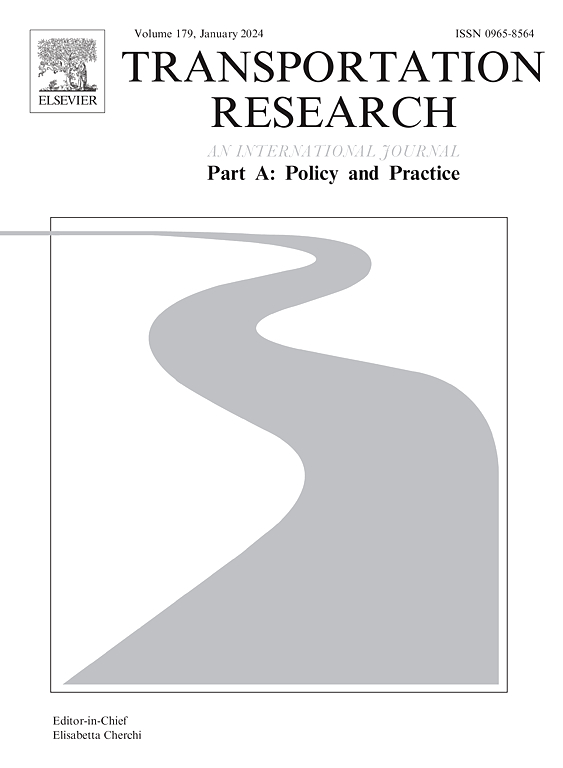在综合模型中绘制工作安排、居住地点和活动参与的相互作用图
IF 6.3
1区 工程技术
Q1 ECONOMICS
Transportation Research Part A-Policy and Practice
Pub Date : 2024-10-20
DOI:10.1016/j.tra.2024.104294
引用次数: 0
摘要
远程办公等虚拟活动已被确定为解决交通拥堵和排放问题的主要出行需求管理策略。然而,能够测试此类策略的综合模型尚未得到适当扩展,以捕捉新出现的活动模式。本研究通过在综合交通、土地利用和排放(iTLE)模型框架内实施个人工作安排并引入居家(IH)虚拟活动,填补了文献空白。首先,该研究在加拿大新斯科舍省哈利法克斯地区市政府(HRM)开展了一项家庭旅行调查,通过问卷调查收集了社会经济、活动旅行和工作相关信息。接下来,它基于混合对数建模(MXL)方法开发了一个工作安排选择模型,并在 iTLE 中实现了该模型。之后,利用马尔可夫链蒙特卡洛(MCMC)建模方法,考虑个人的工作安排、就业和车辆拥有情况,以顺序方式生成个人的日常活动计划。为了展示所开发工具的应用,对个人的社会人口、居住地点、工作地点和活动参与情况进行了纵向模拟,直至 2031 年。对远程工作参数的分析揭示了不同的群组和个人偏好,强调了个性化方法在制定远程工作战略中的重要性。与全职远程工作者相比,大多数非远程工作者的居住地更靠近市中心,而混合型工作者在选择居住地时则表现出集群行为。购物、外出就餐和 IH 维护/自由支配活动的选择增加,而外出工作的选择减少。本文的研究成果将有助于政策制定者和交通研究人员了解工作安排的演变,并研究其对交通和土地使用系统的后续影响。本文章由计算机程序翻译,如有差异,请以英文原文为准。
Mapping the interplay of work-arrangement, residential location, and activity engagement within an integrated model
Virtual activities, such as teleworking have been identified as major travel demand management strategies to tackle traffic congestion and emission. However, integrated models, which are capable of testing such strategies, have not yet been properly extended to capture emerging activity patterns. This study fills-up the literature gap by implementing individuals’ work-arrangement and introducing in-home (IH) virtual activities within an integrated Transport, Land-use, and Emission (iTLE) modeling framework. First, it conducts a household travel survey, which collected socio-economic, activity-travel, and work-related information through a questionnaire survey in the Halifax Regional Municipality (HRM), Nova Scotia, Canada. Next, it develops a work-arrangement choice model based on the mixed-logit modelling (MXL) approach and implements it within iTLE. After that, individuals’ daily activity programs are generated in a sequential manner utilizing a Markov Chain Monte Carlo (MCMC) modelling approach considering their work-arrangement, employment, and vehicle ownership. To demonstrate the application of the developed tool, individuals’ socio-demographics, residential-location, work-location, and activity-participation are longitudinally simulated up to 2031. The analysis of teleworking parameters revealed distinct clusters and individual preferences, emphasizing the significance of personalized approaches in formulating teleworking strategies. Most non-teleworkers stay closer to downtown than full-teleworkers while clustered behavior is observed among hybrid workers for residential location choice. Increase is observed for shopping, dining-out, and IH maintenance/discretionary activities while decrease is observed for out-of-home work. The outcomes of this paper will be helpful for policymakers and transport researchers to understand the evolution of work-arrangement and examine subsequent impacts on transportation and land-use systems.
求助全文
通过发布文献求助,成功后即可免费获取论文全文。
去求助
来源期刊
CiteScore
13.20
自引率
7.80%
发文量
257
审稿时长
9.8 months
期刊介绍:
Transportation Research: Part A contains papers of general interest in all passenger and freight transportation modes: policy analysis, formulation and evaluation; planning; interaction with the political, socioeconomic and physical environment; design, management and evaluation of transportation systems. Topics are approached from any discipline or perspective: economics, engineering, sociology, psychology, etc. Case studies, survey and expository papers are included, as are articles which contribute to unification of the field, or to an understanding of the comparative aspects of different systems. Papers which assess the scope for technological innovation within a social or political framework are also published. The journal is international, and places equal emphasis on the problems of industrialized and non-industrialized regions.
Part A''s aims and scope are complementary to Transportation Research Part B: Methodological, Part C: Emerging Technologies and Part D: Transport and Environment. Part E: Logistics and Transportation Review. Part F: Traffic Psychology and Behaviour. The complete set forms the most cohesive and comprehensive reference of current research in transportation science.

 求助内容:
求助内容: 应助结果提醒方式:
应助结果提醒方式:


